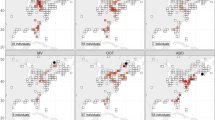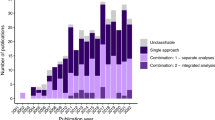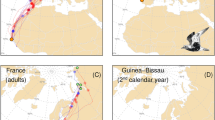Abstract
Ecological barriers represent a challenging and potentially risky component of migratory flyways. Complex patterns involve large arrays of species and huge numbers of birds in crossing deserts, mountain chains and large stretches of sea. Despite the recent rapid developments of new marking technologies, standardised ringing applied to networks of stations widely distributed across the barriers still represents a unique tool to unravel different aspects of the progression of the waves of migration. The Italian Ringing Centre at ISPRA co-ordinates two major projects investigating, respectively, songbird migration across the Mediterranean in spring and over the Alps in autumn. Networks of ringing stations provide details on geographical distribution of flyways based on first-capture data and on species-specific seasonality of movements as also explained by ecological factors acting both on the wintering and breeding grounds. Physical conditions of migrants at different stages of barrier crossing provide details on the energetic cost of endurance flights, contributing to the understanding of the ecological needs of migrants. Conditions of staging migrants, stopover duration and habitat use by migrants significantly contribute to the understanding of time- versus risk-minimizing strategies, within the general framework of the energetic balance of migration. Also, networks represented by the national communities of ringers contribute to the understanding of the ecological role a given country plays within larger migratory flyways. Ringing still offers great potential to analyse existing large-scale and long-term datasets to provide a sound scientific basis for the conservation of migrants.








Similar content being viewed by others
References
Alerstam T (2001) Detours in bird migration. J Theor Biol 194:1–13
Alerstam T, Lindström A (1990) Optimal bird migration: the relative importance of time, energy and safety. In: Gwinner E (ed) Bird migration: physiology and ecophysiology. Springer, Berlin, pp 331–351
Bächler E, Hahn S, Schaub M, Arlettaz R, Jenni L (2010) Year-round tracking of small trans-saharan migrants using light-level geolocators. PLoS ONE 5(3):e9566. doi:https://doi.org/10.1371/journal.pone.0009566
Baillie S, Bairlein F, Clark J, du Feu C, Fiedler W, Fransson T, Hegelbach J, Juillard R, Karcza Z, Keller LK, Kestenholz M, Schaub M, Spina F (2007) Bird ringing for science and conservation. EURING, the European Union for bird ringing. Abächerli Druck, Sarnen
Bairlein F (1992) Recent prospects on trans-Saharan migration of songbirds. Ibis 134:41–46
Bairlein F (1995) Manual of field method. European-African songbird migration network. Institut für Vogelforschung, Wilhelmshaven
Bairlein F (1997) Spatio-temporal conservation, ecology and energetics of Western Palaearctic-African songbird migration. Summary report. Institut fuer Vogelforshung, Wilhelmshaven
Bairlein F (1998) The European-African songbird migration network: new challenges for large-scale study of bird migration. Biol Conserv Fauna 102:13–27
Bairlein F (2004) Large-scale networks in bird research in Europe: pitfalls and prospects. Avian Sci 3:49–63
Bairlein F, Nagel R, Bulte M, Voigt CC, Fox JW, Schmaljohann H (2011) Tracks of geolocators support geospatial predictions of wintering quarters made by stable isotope analysis in a migratory songbird. PlosOne, submitted
Berthold P, Schlenker R (1975) Das “Mettnau-Reit-Illmitz-Programm”—ein langfristiges Vogelfangprogramm der Vogelwarte Radolfzell mit vielfältiger Fragestellung. Vogelwarte 28:97–123
Berthold P, Fliege G, Heim G, Querner U, Schlenker R (1991) Autumn migration, resting behaviour, biometry and moult of small birds in central Europe. Vogelwarte 36(Special issue):1–221
Biebach H (1990) Strategies of trans-desert migrants. In: Gwinner E (ed) Bird migration. Physiology and ecophysiology. Springer, Berlin
Busse P (1974) Biometrical methods. Notakti Orn 15:114–126
Busse P, Kania W (1970) The operation Baltic 1961–1967. Acta Ornithol 12:231–267
Cecere JG (2004) Modalità e strategie di attraversamento del Mediterraneo centro occidentale durante la migrazione primaverile dei passeriformi trans-sahariani. Tesi di Laurea. Facoltà di Scienze Naturali, Università La Sapienza di Roma
Cecere JG, Matricardi C, Frank B, Imperio S, Spina F, Gargallo G, Barboutis C, Boitani L (2010) Nectar exploitation by songbirds at Mediterranean stopover sites. Ardeola 57:143–157
Cecere JC, Spina F, Jenni-Eierman S, Boitani L (2011) Nectar: an energy drink used by European songbirds during spring migration. J Ornithol (in press)
Dolnik VR (1990) Bird migration across arid and mountainous regions of Middle Asia and Kasakhstan. In: Gwinner E (ed) Bird migration: the physiology and ecophysiology. Springer, Berlin, pp 368–386
Fenech N (1992) Fatal flight: the Maltese obsession with killing birds. Quiller, London
Gill RE, Piersma T, Hufford G, Servrancky R, Riegen DG (2005) Crossing the ultimate ecological barrier: evidence for an 11,000 km-long nostop flight from Alaska to New Zealand and eastern Australia by bar-tailed godwits. Condor 107:1–20
Goymann W, Spina F, Ferri A, Fusani L (2010) Body fat influences departure from stopover sites in migratory birds: evidence from whole island telemetry. Biol Lett 6:478–481
Grattarola A, Spina F, Pilastro A (1999) Spring migration of the Garder Warbler (Sylvia borin) across the Mediterranean. J Ornithol 140:419–430
Hepburn JR (1985) La caccia agli uccelli migratori nei Paesi della Comunità Europea. UNAVI, Firenze
Hill GE (1989) Late spring arrival and dull nuptial plumage: aggression avoidance by yearling males? Anim Behav 37:665–673
Hoballah A (1996) Potenzialità di sviluppo nel bacino Mediterraneo. In: Montbailliu X, Torre A (eds) La gestione degli ambienti costieri ed insulari del Mediterraneo. Medmaravis, Alghero, pp 395–404
Jenni L, Jenni-Eiermann S, Spina F, Schwabl H (2000) Regulation of protein breakdown and adrenocortical response to stress in birds during migratory flights. Am J Physiol Regul Integr Comp Physiol 278:R1182–R1189
Kaiser A (1993) A new multi-category classification of subcutaneous fat deposits in songbirds. J Field Ornithol 64:246–255
Licheri D, Spina F (2002) Biodiversità dell’avifauna italiana: variabilità morfologica nei Passeriformi (Alaudidae-Sylviidae). Biol Conserv Fauna 112:1–208
Licheri D, Spina F (2005) Biodiversità dell’avifauna italiana: variabilità morfologica nei non-Passeriformi. Biol Conserv Fauna 114:1–192
Newton I (2008) The migration ecology of birds. Academic, London
Nisbet ICT, Drury WH, Baird J (1963) Weight-loss durino migration. Part 1: deposition and consumption of fat by the black-poll warbler Dendroica striata. Bird-Band 34:107–138
Pedrini P, Rossi F, Rizzolli F, Spina F (2008) Le Alpi italiane quale barriera ecologica nel corso della migrazione post-riproduttiva attraverso l’Europa: risultati generali della prima fase del Progetto Alpi (1997–2002). Biol Conserv Fauna 116:1–336
Pilastro A, Spina F (1997) Ecological barriers and morphological correlates of residual fat reserves in passerine migrants at their spring arrival in southern Europe. J Avian Biol 28:309–318
Pilastro A, Macchio S, Massi A, Montemaggiori A, Spina F (1998) Spring migration routes of eight trans-Saharan passerines through the central and western Mediterranean: results from a network of insular and coastal ringing sites. Ibis 140:591–598
Rubolini D, Spina F, Saino N (2004) Protandry and sexual dimorphism in trans-Saharan migratory birds. Behav Ecol 15:592–601
Rubolini D, Spina F, Saino N (2005) Correlates of timing of spring migration in birds: a comparative study of trans-Saharan migrants. Biol J Linn Soc 85:199–210
Saino N, Rubolini D, Serra L, Caprioli M, Morganti M, Ambrosini R, Spina F (2010) Sex-related variation in migration phenology in relation to sexual dimorphism: a test of competing hypotheses for the evolution of protandry. J Evol Biol 23:2054–2065
Salewski V, Almasi B, Schlageter A (2006) Nectarivory of Palearctic migrants at a stopover site in the Sahara. Br Bird 99:299–305
Schaub M, Jenni L (2000) Body mass of six long-distance migrant passerines species alonf the autumn migration route. J Ornithol 141:441–460
Schaub M, Jenni L (2001) Stopover duration of three warbler species along their autumn migration route. Oecologia 128:217–227
Schmaljohann H, Fox J, Bairlein F (2011) Tracking the annual cycle of a high-Arctic songbird migrants suggests a strong endogenously controlled migration strategy. Proc R Soc Lond B submitted
Schwilch R, Mantovani R, Spina F, Jenni L (2001) Nectar consumption of warblers after long-distance flights during spring migration. Ibis 143:24–32
Schwilch R, Grattarola A, Spina F, Jenni L (2002) Protein loss during long distance migratory flight in passerine birds: adaptation and constraint. J Exp Biol 205:687–695
Sillet TS, Holmes RT (2002) Variation in survivorship of a migratory songbird throughout its annual cycle. J Anim Ecol 71:296–308
Spina F, Massi A, Montemaggiori A, Baccetti N (1993) Spring migration across Central Mediterranean: general results from the ‘Progetto Piccole Isole’. Die Vogelwarte 37(Suppl):1–98
Spina F, Massi A, Montemaggiori A (1994) Back from Africa: who’s running ahead? Differential migration of sex and age classes in Palearctic-African spring migrants. Ostrich 65(Suppl):137–150
Spina F, Licheri D (2003) Biodiversità dell’avifauna italiana: variabilità morfologica nei Passeriformi (Muscicapidae-Emberizidae). Biol Conserv Fauna 113:1–180
Stutchbury BJM, Tarof SA, Done T, Gow EA, Kramer PM, Tautin J, Fox JW, Afanasyev V (2009) Tracking long-distance songbird migration by using geolocators. Science 323:896
Stutchbury BJM, Gow EA, Done T, MacPherson M, Fox JW, Afanasyev V (2010) Effects of post-breeding moult and energetic condition on timing of songbird migration into the tropics. Proc R Soc Lond B. doi:https://doi.org/10.1098/rspb.2010.1220
Tenan S, Spina F (2010) Timing and condition-related affects on recapture probability, mass change and stopover length of spring migrating songbirds on a small Mediterranean island. Ardeola 57(1):121–132
Woldhek S (ed) (1980) Bird killing in the Mediterranean. International Council of Bird Preservation, Zeist
Acknowledgments
I wish to thank Prof. Franz Bairlein for inviting me to report on our network projects at the Celebration meeting for the 100 Years of Vogelwarte Helgoland. My deep appreciation and warmest thanks to the hundreds of volunteer ringers who contribute to carry on such demanding projects. The Alps Project is crucially supported by the Trento Museo delle Scienze. Results of the Progetto Piccole Isole ISPRA: paper no. 50.
Author information
Authors and Affiliations
Corresponding author
Additional information
Communicated by F. Bairlein.
Rights and permissions
About this article
Cite this article
Spina, F. Joint ringing efforts to unravel complex migratory patterns across ecological barriers: the potential of networking. J Ornithol 152 (Suppl 1), 41–48 (2011). https://doi.org/10.1007/s10336-011-0715-0
Received:
Revised:
Accepted:
Published:
Issue Date:
DOI: https://doi.org/10.1007/s10336-011-0715-0




